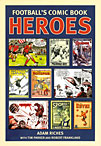 by Adam Riches
by Adam Riches
Mainstream, £19.99
Reviewed by Frank Plowright
From WSC 271 September 2009
We all know Roy of the Rovers, and more recently Striker, but memories of further football heroes from comics are murky. The many hours spent by Adam Riches poring through the comics in the National Publication Archives make him the man to fill us in.
Today even journeymen players attract regular tabloid coverage, so it’s difficult to conceive that until the 1930s football was considered only of fleeting interest. Newspaper readers were lucky to see results, never mind anything further, and football literature was equally scarce. It leaves comics, and their predecessors, the boys’ papers, as a rare source of information as to how the game was perceived in the early days of professionalism, albeit skewed by demands for a sensational story that also encompassed edifying principles.
Early comics identify football as a working-class game, and are liberally sprinkled with messages intended to provide an example. Fair play is emphasised, and there are exhortations toward purportedly higher ethics including encouraging boys to join the army during the First World War.
Sinister land-grabbing chairmen abound and many ideas considered eccentric or outlandish in the comics of yesteryear are now commonplace. Computer generated statistics and interpretation in several stories predate Prozone by decades, the Ninety Minute Marvels were given performance enhancing chemicals, and in 1956 Melchester Rovers signed a French player. Dozy Danny dilutes the youthful experiences of Bill Foulkes and Jack Charlton among others, who earned a living as miners before training at night. Danny was turfed from his bed at 4am by his stepfather to make coal briquettes. There’s occasionally a horrendous prescience, such as Gorgeous Gus’s 1957 story about rebuilding an entire team after their predecessors died in a plane crash.
Plenty of stories are ludicrously contrived: a Nazi considering his best chance of concealment is among a football team, or a player targeted during a match by triads. Then there is the aforementioned Gorgeous Gus, the Earl of Boote. He finances Redburn Rovers and plays centre-forward when his schedule of meetings with foreign royalty permit. Editorial compulsion to assign players alternative careers was frequent. A single page dealing with 1930s football stories notes three moonlighting film stars and Steve Bradshaw, whose alternative skill was cracking safes. It wasn’t until Roy of the Rovers debuted in 1954 that editors realised football itself provided enough drama.
There is the suspicion throughout that the synopses of stories from the boys’ papers are far more entertaining than wading through them. This is confirmed by the inclusion of a 40-page composite comic culled from publications through the decades, presenting three illustrated text stories spanning 1910 to 1944, and the later exploits of Nipper and Billy’s Boots, which can still raise a smile. It’s a niche market, but if you need a book on football comics, this is the one to have.